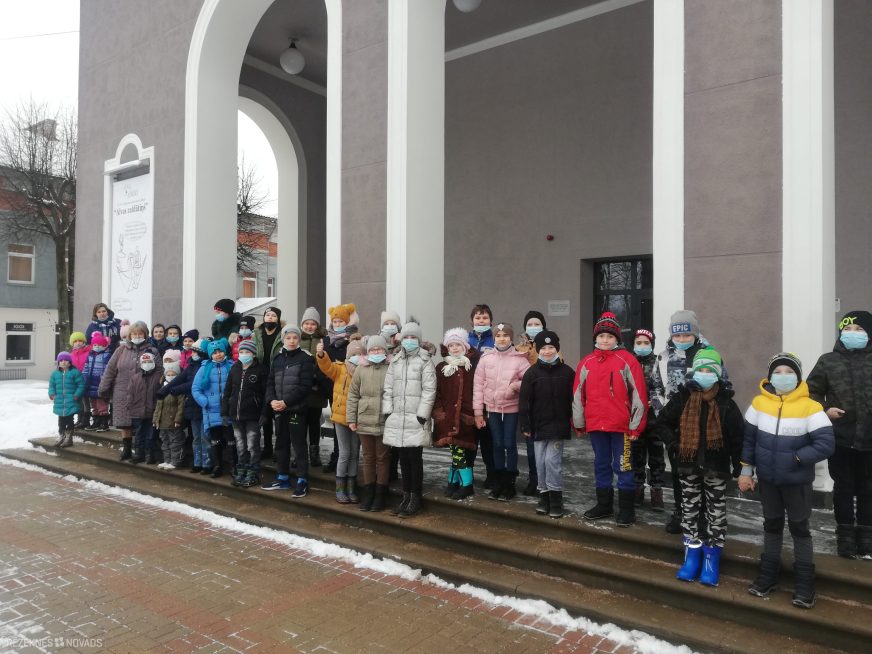Programme “Latvian School Finish” Tisky Secondary School 2021./2022.m. 2 nd Semester

High school students are actively continuing to participate in the activities offered by the “Latvian School Finish”. Rich and diverse cultural activities and activities of Latvia provide a comprehensive development of our pupils, provide them with new knowledge, expand vision and help learn the content of learning.
The 2 nd semester activities started with two theatre shows.
In remembering and mentioning the time of the barricades, students of Classes 8, 9 and 12 of the High School went to the Rēzekne City Theatre “Joriks” to watch the exhibition “barricades. docx”. The show is based on the memory of Latgale and Vidzeme Baricades, who were 18 – 25 years old in 1991. The performances were studying the importance of the barricades in the lives of their participants, deepening into their memories, sensing them to survive 30 years later on the theatre stage. The largest unknown is the attack of 20 January on the building of the Ministry of Interior. The show's story is about Eddie's walnut, the boy who died in these days, about the memories, experiences and emotions of each member who lived in January 1991. In the course of the show, the experience of each member's barricades – chronological, from start to end – is reported. We found answers to a number of questions: what was it talking about? What was he thinking? What was he worried about? What did they eat? What songs were singing to the fire? Was it scared? Was it cold?
It was interesting to show the chronology of historical events, as a live video game (the camera provoked an event story on a big screen, parallel to stories, showing and drawing everything as a reporter). During the show, there was a number of the most popular songs of that time 'dance,' under two flags', 'mother tongue' and others. The performance was mostly for all pupils. New knowledge was very useful in the learning of both history, music and Latvian language learning and, of course, contributed to the emergence of civil participation and patriotism.
The primary school pupils watched the show 'tin soldier. The immortal story of the Danish writer Hans Kristiana Andersen on the children of the “folk soldiers” allowed him to know this strange world, in which, despite all occurrences, we were at the destination.
The actor - Jekaterina Garfunkele and Carl tol - showed H. K. Andersen's story in a new unusual form: used the elements of the game, involving children in the performance – asked questions, sang, sound and play songs. The children sat on the stage and were not only the spectators, but the fairy-tales. It was a familiar and interesting story (in Latvian) with several humoristic moments. Of course, the good and evil struggle existed, but it was triumphant.
Classes 1-4 watched the show on stage, then discussed it for a long time. After reviews, the pupils enjoyed the performance and they could use the skills they acquired in a theatre group, a number of domestic situations, drama subjects, and they developed their Latvian language skills.
Several pupils liked the show, the gorgeous clothes, the dolls, masks and decorations from the paper, the actors' transformation – two actors played several roles (rats, fish, cats, housekeepers, fishermen), fun moments, actor emotionality, and their singing during the performance. It wasn't hard for anyone to see the show in Latvian, because the story is familiar and the children enjoyed it with interest.
On 6 April, the group of classes 5-7 went on a training trip to Latgale's art and craft centre and the Livani glass museum. The staff of the art and craft centre told the pupils that in 1887, a glass factory was built in Livenhof's barley because of the quartz sands, the broken dolomite, which was favourable to the production of glass. During the excursion, the pupils introduced the history and development of the glass museum. In the exhibition they saw exhibits produced in the Livans glass factory. These are high-quality coloured and colourless glass products: bottles, glasses, light bodies, vases, candles. In almost every house in Latvia, the magnificent glass of Livans can be found in the depths of mothers or grandmother buffers.
After the Livani glass museum, pupils surveyed the exhibition “amateurs in Latgale in the 19 th-20 th century”, where the work tools used in our ancestral farm were collected. This exhibition shows Latvia's unique 94 metres long national belt.
With great interest, the children also looked at the glass blowing workshop. Two men (glass puffers) continue and protect the old glass blowing tradition. They are real wizards who are able to connect sand grains to chemical agents and heat all together at a very high temperature. As a result, a mass of liquid glass is produced, which is a miracle of transformation in the hands of the master, and is transformed, for example, in a cocktail! Our pupils had the opportunity to ask masters about the work of craftsmen, materials, tools and equipment. The pupils learned a lot of new, interesting information and persuaded that chemistry was a very fascinating science, with the help of many miracles. Class 5 pupils updated their knowledge “what is natural resources and how they are used?”, while class 6 pupils – the themes “how the transformation of substances takes place?”. Class 7 students are impatiently waiting for the next year of training as the new subject of learning – chemistry.
All pupils admitted that the trip was useful, informative and exciting.
Thank the “Latvian School Finish” for the opportunity to develop and educate our pupils.
.
Deputy Director-General of Tisky High School, Irina Scherbacov
photo: Luda Shchemewa



